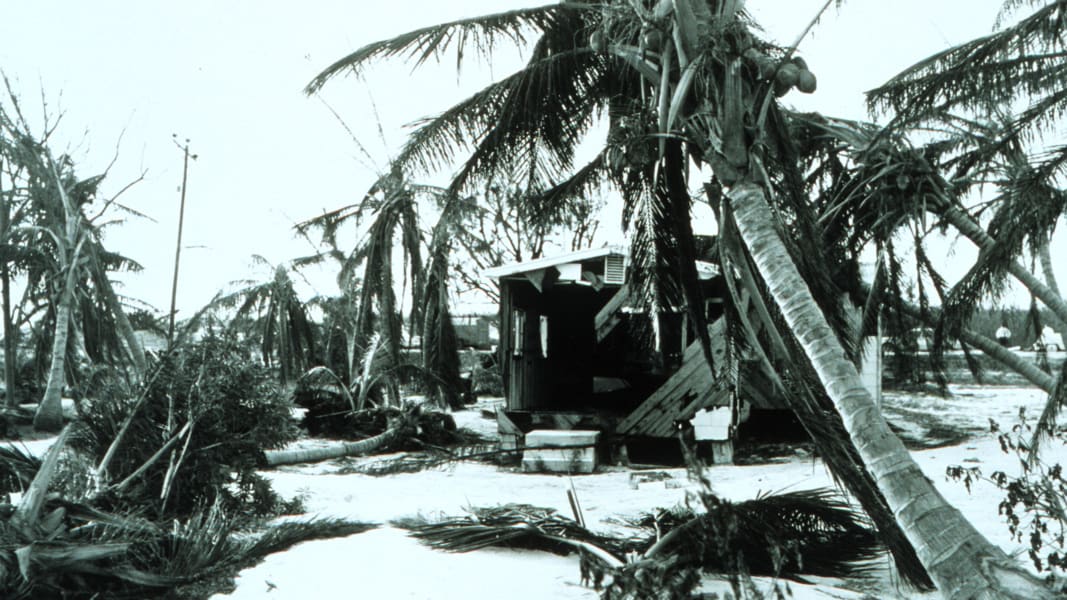Share


1 of 13
Historically, the worst part of the Atlantic hurricane season stretches from the last part of August through September and October, according to the National Weather Service. In late October 2012, Superstorm Sandy crashed into the northeastern United States, creating extensive damage to parts of New York, New Jersey, Connecticut, Rhode Island and Massachusetts. Click through the gallery to see more photos of disasterous U.S. hurricanes, and facts from the National Hurricane Center. Allison Joyce/Getty Images
On September 13, 2008, Ike hit Galveston Island, Texas, as a Category 2 hurricane with maximum sustained winds of 110 mph. Little was left standing where this photo was taken in Gilchrist, Texas. Ike was blamed for scores of deaths in the Caribbean and in the United States. Property damage was estimated at $19.3 billion. Mark Wilson/Getty Images
Unforgettable Hurricane Katrina devastated the Gulf Coast in 2005, making landfall near Buras, Louisiana, on August 29 as a Category 3 storm with maximum winds estimated at 125 mph. Katrina was blamed for more than 1,200 reported deaths in Louisiana, Mississippi and Florida. Estimated property damage: $75 billion, the costliest U.S. hurricane on record. Kyle Niemi/U.S. Coast Guard via Getty Images
Just weeks after the horror of Katrina, Hurricane Rita collided with the Louisiana coast on September 24, 2005, as a Category 3 storm with maximum sustained winds of 115 mph. Rita's massive damage included this washed out road in Cocodrie, Louisiana. Sandy Huffaker/Getty Images
August 13, 2004, Hurricane Charley pushed ashore near Captiva Island, Florida, as a Category 4 storm with maximum winds near 150 mph. It devastated Port Charlotte and Punta Gorda, where a recreational vehicle was found resting against a tree. Charley then moved into the Carolinas to do more damage there. Overall, at least 15 people were killed. Estimated damage: $15 billion. Tim Boyles/Getty Images
On September 6, 2004, Frances made landfall in the Florida Big Bend region as a tropical storm, after peaking in the Caribbean as a Category 4 hurricane with 145 mph winds. The storm spawned more than 100 tornadoes throughout the southeastern and mid-Atlantic states. Frances was blamed for eight deaths -- seven in the United States and one in the Bahamas. U.S. damage was estimated around $8.9 billion. Chris Hondros/Getty Images
Just three weeks after Frances, on September 26, 2004, Hurricane Jeanne's 60-mile-wide eye crossed the Florida coast near Stuart, at virtually the same place Frances made landfall. Maximum winds were estimated at 120 mph. The storm tore apart this auto shop in Sebastian, Florida. Jeanne was blamed for three deaths in Florida, and one each in Puerto Rico, South Carolina and Virginia. Joshua Rodas/Getty Images
On September 16, 2004, Hurricane Ivan's maximum sustained winds of 120 mph crashed into Alabama, just west of Gulf Shores, with damage spreading across the region to Milton, Florida, seen here. When it was all said and done, Ivan was blamed for 92 deaths across the United States, Grenada, Jamaica, Dominican Republic, Venezuela, Cayman Islands, Tobago and Barbados. U.S. damage was estimated at $14.2 billion, the third largest total on record. Stacey Pardini/U.S. Coast Guard via Getty Images
Hurricane Andrew blasted its way across south Florida on August 24, 1992, as a Category 4 with peak gusts measured at 164 mph. After raking entire neighborhoods in and around Homestead, Florida, Andrew moved across the Gulf to hit Louisiana as a Category 3 hurricane. Andrew is responsible for 23 deaths in the United States and three in the Bahamas. Estimated U.S. damage: $26.5 billion. Paul J. Richards/AFP/Getty Images
On August 17, 1969, Camille -- a Category 5 hurricane -- rushed ashore along the Mississippi coast. The storm made trouble even for large ships in Gulfport. Camille's winds, surges and rainfalls caused 256 deaths, including 143 on the Gulf Coast and 113 in related Virginia floods. Three deaths were reported in Cuba. Estimated damage: $1.421 billion. NOAA
Donna is the only hurricane of record to produce hurricane-force winds in Florida, the Mid-Atlantic states and New England. It crossed Florida on September 11, 1960, as seen in this photo taken in Islamorada Key. Then the hurricane blew into eastern North Carolina as a Category 3 on the 12th, and New England as a Category 3. Donna is blamed for 50 deaths in the United States and hundreds more in the Caribbean. Estimated damage: $387 million in the United States and $13 million elsewhere. American Red Cross/NOAA
"The Great Miami Hurricane" of 1926 was a Category 4 when it raced across Miami Beach and downtown Miami during the morning hours of September 18. Although its death toll is uncertain, more than 800 people were reported missing, and a Red Cross report lists 373 deaths. If the disaster had occurred in modern times, its estimated cost would be $90 billion. R. B. Holt/MPI/Getty Images
The nation's deadliest hurricane was a September storm. On September 8 the Galveston Hurricane of 1900 slammed into Texas. Storm tides of 8-15 feet are largely blamed for the hurricane's estimated 6,000 to 12,000 deaths. Property damage has been estimated at $30 million. FPG/Hulton Archive/Getty Images




















